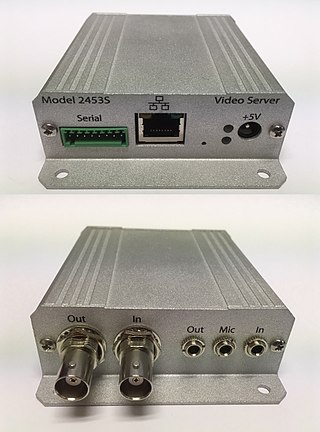
Integrated Services Digital Network (ISDN) is a set of communication standards for simultaneous digital transmission of voice, video, data, and other network services over the digitalised circuits of the public switched telephone network. Work on the standard began in 1980 at Bell Labs and was formally standardized in 1988 in the CCITT "Red Book". By the time the standard was released, newer networking systems with much greater speeds were available, and ISDN saw relatively little uptake in the wider market. One estimate suggests ISDN use peaked at a worldwide total of 25 million subscribers at a time when 1.3 billion analog lines were in use. ISDN has largely been replaced with digital subscriber line (DSL) systems of much higher performance.
The Session Initiation Protocol (SIP) is a signaling protocol used for initiating, maintaining, and terminating communication sessions that include voice, video and messaging applications. SIP is used in Internet telephony, in private IP telephone systems, as well as mobile phone calling over LTE (VoLTE).
Voice over Internet Protocol (VoIP), also called IP telephony, is a method and group of technologies for the delivery of voice communications and multimedia sessions over Internet Protocol (IP) networks, such as the Internet. The terms Internet telephony, broadband telephony, and broadband phone service specifically refer to the provisioning of communications services over the Internet, rather than via the public switched telephone network (PSTN), also known as plain old telephone service (POTS).
Ericsson Television, formerly Tandberg Television, is a company providing MPEG-4 AVC, MPEG-2 and HEVC encoding decoding and control solutions, plus stream processing, packaging, network adaption and related products, for Contribution & Distribution (C+D), IPTV, Cable, DTT, Satellite DTH and OTT.
HCL Sametime Premium is a client–server application and middleware platform that provides real-time, unified communications and collaboration for enterprises. Those capabilities include presence information, enterprise instant messaging, web conferencing, community collaboration, and telephony capabilities and integration. Currently it is developed and sold by HCL Software, a division of Indian company HCL Technologies, until 2019 by the Lotus Software division of IBM.

Asterisk is a software implementation of a private branch exchange (PBX). In conjunction with suitable telephony hardware interfaces and network applications, Asterisk is used to establish and control telephone calls between telecommunication endpoints, such as customary telephone sets, destinations on the public switched telephone network (PSTN), and devices or services on voice over Internet Protocol (VoIP) networks. Its name comes from the asterisk (*) symbol for a signal used in dual-tone multi-frequency (DTMF) dialing.

A video server is a computer-based device that is dedicated to delivering video. Video servers are used in a number of applications, and often have additional functions and capabilities that address the needs of particular applications. For example, video servers used in security, surveillance and inspection applications typically are designed to capture video from one or more cameras and deliver the video via a computer network. In video production and broadcast applications, a video server may have the ability to record and play recorded video, and to deliver many video streams simultaneously.

Videotelephony, also known as videoconferencing and video teleconferencing, is the two-way or multipoint reception and transmission of audio and video signals by people in different locations for real time communication. A videophone is a telephone with a video camera and video display, capable of simultaneous video and audio communication. Videoconferencing implies the use of this technology for a group or organizational meeting rather than for individuals, in a videoconference. Telepresence may refer either to a high-quality videotelephony system or to meetup technology, which can go beyond video into robotics. Videoconferencing has also been called "visual collaboration" and is a type of groupware.
A POTS codec is a type of audio coder-decoder (codec) that uses digital signal processing to transmit audio digitally over standard telephone lines at a higher level of audio quality than the telephone line would normally provide in its analog mode. The POTS codec is one of a family of broadcast codecs differentiated by the type of telecommunications circuit used for transmission. The ISDN codec, which instead uses ISDN lines, and the IP codec which uses private or public IP networks are also common.

H.323 is a recommendation from the ITU Telecommunication Standardization Sector (ITU-T) that defines the protocols to provide audio-visual communication sessions on any packet network. The H.323 standard addresses call signaling and control, multimedia transport and control, and bandwidth control for point-to-point and multi-point conferences.
Telos Alliance is an American corporation manufacturing audio products primarily for broadcast stations. Headquartered in Cleveland, Ohio, USA, the company is divided into six divisions:
Audio over IP (AoIP) is the distribution of digital audio across an IP network such as the Internet. It is used increasingly to provide high-quality audio feeds over long distances. The application is also known as audio contribution over IP (ACIP) in reference to the programming contributions made by field reporters and remote events. Audio quality and latency are key issues for contribution links. In the past, these links have made use of ISDN services but these have become increasingly difficult or expensive to obtain.

aptX is a family of proprietary audio codec compression algorithms owned by Qualcomm, with a heavy emphasis on wireless audio applications.
IP codecs are used to send video or audio signals over an IP network such as the Internet. The initials "IP" here stand for "Internet Protocol", while the term "codec" is short for "encoder/decoder" or "compressor/decompressor".
Aculab is a privately held, UK-based limited company that was founded in 1978. It is a designer, developer and manufacturer that specialises in providing API-driven, enabling technology sub-systems for telecommunications related OEM products such as are used in fixed line PSTN, wireless and VoIP networks. Aculab's products are sold worldwide, primarily through direct sales and also via the reseller channel. Aculab's headquarters and R&D facilities are located in Milton Keynes, UK. It has a branch office in Norwood, Massachusetts, USA.

PictureTel Corporation, often shortened to PictureTel Corp., was one of the first commercial videoconferencing product companies. It achieved peak revenues of over $490 million in 1996 and 1997 and was eventually acquired by Polycom in October 2001.
Total conversation is an ITU standard of simultaneous video, voice and text service in telecommunications. Total conversation allows people in two or more locations to: (a) see each other, (b) hear each other, and (c) conduct a text interaction with each other, or choose to communicate with any combination of those three modes and to do so in real-time.
AES67 is a technical standard for audio over IP and audio over Ethernet (AoE) interoperability. The standard was developed by the Audio Engineering Society and first published in September 2013. It is a layer 3 protocol suite based on existing standards and is designed to allow interoperability between various IP-based audio networking systems such as RAVENNA, Livewire, Q-LAN and Dante.
ipDTL is an IP codec running in a web browser, used for remote broadcasts in television, radio, and voice-over. It is a replacement and compatible with older ISDN audio codecs. Then, it is also capable of video transmissions and can be used in the field with some mobile devices.
Comrex is an American corporation that designs and manufactures equipment for radio and television broadcasting.







